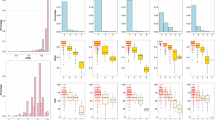Abstract
Two common formats for grading quality of life parameters are descriptive choices (mild, moderate, severe) and visual analogue scales. However the quantitative relationship between descriptive terminology and visual analogue scale scores has not been determined. A content neutral questionnaire was administered to 213 evaluable subjects who were asked to place the descriptors ‘mildly’, ‘moderately’, and ‘severely’ (presented in random order) on 100mm visual analogue scales. Visual analogue scales were presented without and then with hashmarks at 25mm, 50mm, and 75mm. Median visual analogue scale values for the descriptive terms differed significantly without hashmarks (‘mildly’=24mm’, ‘moderately’=43mm, ‘severely’=84mm; p<0.001) and also with hashmarks (‘mildly’=31mm, ‘moderately’=49mm, ‘severely’=85mm; p<0.001). Comparison of interquartile range values (25th–75th percentile) revealed a distinct meaning for ‘severely’ (68–93mm) but marked overlap between ‘mildly’ (10–45mm) and ‘moderately’ (22–53mm). Errors of order (order other than ‘mildly’ < ‘moderately’ < ‘severely’) were made by 91 subjects. The discrepancy ‘moderately’ < ‘mildly’ accounted for most of these errors (72 subjects). Median values for ‘mildly’, ‘moderately’, and ‘severely’ are distinct and approximately linear on a visual analogue scale for large populations. However there is significant confusion between the terms ‘mildly’ and ‘moderately’ for individual subjects. Visual analogue scales can reveal finer quantitative differences than descriptive terms but require a significant time commitment for instruction and administration. Descriptive terms on a word-graphic scale or descriptive terms with numerical values to reenforce order of severity (0=absent, 1=‘mildly’, 2=‘moderately’, 3=‘severely’) may be reasonable alternatives.
Similar content being viewed by others
References
Cella DF, Tulsky DS. Quality of life in cancer: Definition, purpose, and method of measurement. Cancer Invest 1993; 11: 327–336.
Detsky AS, Naglie IG. A clinician's guide to cost-effectiveness analysis. Ann Intern Med 1990; 113: 147–154.
Schipper H, Levitt M. Measuring quality of life: Risks and benefits. Cancer Treat Rep 1985; 69: 1115–1123.
Aaronson NK. Methodological issues in psychosocial oncology with special reference to clinical trials. In: Ventafridda V, Van Dam FSAM, Yancik R, Tamburini M, eds. Assessment of Quality of Life and Cancer Treatment. Amsterdam: Elsevier, 1986; 29–42.
Tesler MD, Savedra MC, Holzemer WL, Wilkie DJ, Ward JA, Paul SM. The word-graphic rating scale as a measure of children's and adolescents' pain intensity. Res Nurs Health 1991; 14: 361–371.
Hollander M, Wolfe DA. Nonparametic Statistical Methods. New York: J Wiley & Sons, 1973.
Baños JE, Bosch F, Cañellas M, Bassols A, Ortega F, Bigorra J. Acceptability of visual analogue scales in the clinical setting: A comparison with verbal rating scales in post-operative pain. Methods Find Exp Clin Pharmacol 1989; 11: 123–127.
Lee KA, Hicks G, Nino-Murcia G. Validity and reliability of a scale to assess fatigue. Psychiatry Res 1991; 36: 291–298.
Monk TH. A visual analogue scale technique to measure global vigor and affect. PsychiatryRes 1989; 27: 89–99.
Little K, Penman E. Measuring subacute mood changes using the profile of mood states and visual analogue scales. Psychopathology 1989; 22: 42–49.
Chernik DA, Gillings D, Laine H, Hendler J, Silver JM, Davidson AB, et al. Validity and reliability of the observer's assessment of alertness/sedation scale: Study with intravenous midazolam. J Clin Psychopharmacol 1990; 10: 244–251.
Cull A. Psychological effects of anti-cancer therapy. In: Andrews PRL, Sanger GJ, eds. Emesis in Anti-Cancer Therapy—Mechanisms and Treatment. London: Chapman & Hall Medical, 1993; 211–228.
Hollen PJ, Gralla RJ, Kris MG, Potanovich LM. Quality of life assessment in individuals with lung cancer: Testing the Lung Cancer Symptom Scale (LCSS). Eur J Cancer 1993; 29A (Suppl 1): S51-S58.
Gift AG. Validation of a vertical visual analogue scale as a measure of clinical dyspnea. Rehabil Nurs 1989; 14: 323–325.
Ballatori E, Roila F, Basurto C, Bracarda S, Picciafuoco M, Soldani M, et al. Reliability and validity of a quality of life questionnaire in cancer patients. Eur J Cancer 1993; 29A (Suppl 1): S63-S69.
Callahan LF, Brooks RH, Summey JA, Pincus T. Quantitative pain assessment for routine care of rheumatoid arthritis patients, using a pain scale based on activities of daily living and a visual analog pain scale. Arthritis Rheum 1987; 30: 630–636.
Jaeschke R, Singer J, Guyatt GH. A comparison of sevenpoint and visual analogue scales—Data from a randomized trial. Controlled Clin Trials 1990; 11: 43–51.
Langley GB, Sheppeard H: The visual analogue scale: Its use in pain measurement. Rheumatol Int 1985; 5: 145–148.
Author information
Authors and Affiliations
Rights and permissions
About this article
Cite this article
Grunberg, S.M., Groshen, S., Steingass, S. et al. Comparison of conditional quality of life terminology and visual analogue scale measurements. Qual Life Res 5, 65–72 (1996). https://doi.org/10.1007/BF00435970
Received:
Accepted:
Issue Date:
DOI: https://doi.org/10.1007/BF00435970




